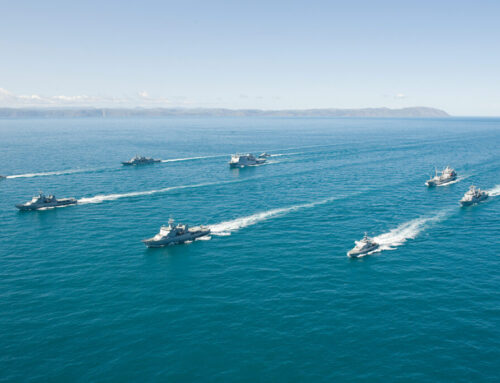PP ANALYSIS Premises, circumstances and course of the Danish 5th generation fighter procurement programme – a valuable lesson for Poland
Autor foto: Domena publiczna

Premises, circumstances and course of the Danish 5th generation fighter procurement programme – a valuable lesson for Poland?
October 4, 2017
Author: Grzegorz Rdzanek




PP ANALYSIS Premises, circumstances and course of the Danish 5th generation fighter procurement programme – a valuable lesson for Poland
Autor foto: Domena publiczna
Premises, circumstances and course of the Danish 5th generation fighter procurement programme – a valuable lesson for Poland?
Author: Grzegorz Rdzanek
Published: October 4, 2017
Pulaski Policy Paper no 22, October 4, 2017
Since the beginning of 2017, representatives of the Polish Ministry of Defence have several times indicated the need to replace the obsolete and worn-out legacy Soviet aircraft – Su-22 and MiG-29 – with multi-role fifth generation aircraft. The 2017 Strategic Defence Review underscored the need for acquiring new generation aircraft as a part of the “Harpia” (“Harpy”) programme. It is evident, that when planning and implementing long term, complex and expensive armament projects, the Polish authorities should make use of the experience accumulated by other European states, that have recently concluded their respective selection procedures. One might say, that the Danish combat aircraft acquisition procedure (which was concluded in mid-2016) could serve as a blue-print of an effective tender, while the institutional, legal and functional elements of the tender (that taken together constitute an integrated military procurement system) should be used as a basis for tendering procedures in other European states.
In the context of Polish future acquisition programme, the case study of Denmark is relevant for other reasons as well. The financial resources that the Kingdom of Denmark can devote to the programme acquiring new aircraft are limited. Like Poland’s, Danish defence policy is tightly linked to the security strategy of the United States. Moreover, the core assumptions behind the role of the Danish Air Force are relatively similar to the Polish doctrine (cooperation with Allied Forces, participation in the multinational air missions, strategic air operations, operations against land and sea based adversary assets, achieving and maintaining air superiority).Currently, the Royal Danish Air Force is using the General Dynamics F-16 Fighting Falcon, which were first introduced in the beginning of the 1980s. According to the official data, 33 of these aircraft remain operational. Maintenance costs needed to keep the aging jests airworthy are perpetually increasing, while at the same time the maintenance itself becomes problematic from a technical standpoint. Regular malfunctions and incidents involving the F-16 compelled the Danish authorities to seek out a new aircraft.
The beginning of the Danish search for a new aircraft.
The fifth generation jet fighter procurement procedure was first initiated by the Defence Commission of Folketing – the Parliament of the Kingdom of Denmark. The decision was included in the Danish Defence Agreement – the key document outlining mid-term defence strategy of Denmark, which was adopted by the Danish parliament in 2009.
The relevant provisions of the Danish Defence Agreement were worded as follows: The Parties to the Defence Agreement are therefore in agreement that the Danish Armed Forces must maintain a combat aircraft capability for upholding the sovereignty of domestic air space as well as the surveillance and patrol of areas of national interest. Furthermore, the Danish Armed Forces must continue to maintain the capability for deploying combat aircraft in international operations.
The members of the Defence Committee have also listed a number of factors that had to be taken into consideration by the government during the acquisition procedure including the final selection of the entries. These factors included:
- Security Policy – the aircraft selected should ensure the realisation of Denmark’s vital security interests
- Strategic Dimension – the purchase of a new generation aircraft must strengthen the political-military ties between Denmark and its closest allies;
- Technical and Tactical specification – the future Danish aircraft should be characterised by parameters consistent with the expectations formulated by the Air Force Command;
- Financial Issues – the purchase price and the maintenance costs should not exceed the budgetary and financial resources devoted to the modernisation of armed forces.
- Industrial Cooperation – the manufacturer of the aircraft must guarantee an extensive participation of Danish entities in the production process.
It is important to note, that the Defence Commission has a special role in the Danish Defence Planning. Unlike the Permanent Folketing Defence Committee (Forvarsudvalget), it is only appointed when decisions crucial for the Danish Defence Policy are made. It is chaired by the representatives of all parties in the Parliament. Consent of all the members of the Committee, including the opposition, is necessary in order to adopt any decision. This procedure means, that any decision made by the Defence Committee is consistently implemented, regardless of the current make-up of the government. Furthermore, the Defence Commission allocates, in four year increments the financial resources needed for implementing the procurement programs. The decision to purchase multi-role aircraft for Danish Air Force was reaffirmed in the next defence agreement – the Danish Defence Agreement 2013-2017, which was concluded in November 2012.
Tender Procedure
Even though the initial analyses regarding the future Danish jet fighter were initiated in 2007 and 2008, the formal selection procedure was started in 2013. From the very onset of the acquisition process, the Danish authorities have taken all necessary steps to make the New Fighter Programme as transparent as possible, with the final decision resulting based on a set of clearly defined, objective and tangible premises. Denmark’s two most prominent public auditing institutions were involved in the supervision of the programme: Rigsrevisionen (The National Audit Office) and the parliamentary public expenditure committee (The Public Accounts Committee). Simultaneously, the Danish government hired two independent auditing companies to evaluate the submitted bids. Each of the formally submitted offers underwent a thorough, multidimensional evaluation, which took the above-mentioned requirements into account: of a strategic, military, economic and industrial concerns. Ultimately, the list was narrowed down to three entries:
- Airbus – EADS with Eurofighter Typhoon
- Lockheed Martin with F-35 Joint Strike Fighter
- Boeing with F/A-18E/F Super Hornet
When evaluating each of the proposals, 30 year service life period was specified as one of the requirements, along an unconditional requirement to perform a full range of tasks currently carried out by the F-16’s (including protecting the airspace, engaging enemy aircraft, providing air support for land forces operations, participation in international operations). It is worth a mention, that the Swedish manufacturer of the JAS-39 Grippen – SAAB appeared to be seriously interested in participating in the competition until 2014. Ultimately, however the Swedish government decided not to bid in the tender, refusing to participate in the questioning phase and thus withdrew from the competition. Formulating the exhaustive and nuanced list of over 950 questions (Request for Binding Information) was the culminating moment of the procurement programme. At the same time, a special team was established within the Danish Ministry of Defence. Its mission was to organise expert panels tasked with analysing bidders’ responses, evaluate them, and then ranking the responses with respect to strategic, military, economic and industrial aspects.
Table 1. Final rank of the offers in terms of each of the graded dimensions
| Rank | Strategic Aspects | Military Dimension | Economic Dimension | Industrial Aspects |
| 1. | Joint Strike Fighter | Joint Strike Fighter | Joint Strike Fighter | Joint Strike Fighter |
| 2. | Eurofighter | Super Hornet | Super Hornet | Super Hornet |
| 3. | Super Hornet | Eurofighter | Eurofighter | Eurofighter |
Selection of the Lockheed Martin bid.
Based on recommendations provided by the evaluation team operating within the frameworks set up by the New Fighter Programme, conservative-liberal government of Lars Løkke Rasmussen requested the parliament to agree to the purchase of 27 F-35A’s. In June 2016 Folketing green lighted the transaction, while at the same time allocating 20b Danish Crowns (approx.. $3b) towards this purpose. In relation to particular assessment, criteria the following aspects determined the choice of the Joint Strike Fighter:
- As far as the strategic dimension was concerned, Danish authorities recognised, that the Lockheed Martin proposal would allow to best realise the demands outlined in the national security strategy both in the near future, and in the coming decades. The potential for modernisation of this aircraft guarantees continuous adaptation to the demands of the battlefield of the future, evolving warfare and changing security landscape of the Kingdom of Denmark. It was also emphasised that the purchase of the F-35A aircraft would strengthen the transatlantic relationship with the United States, and would enhance the cooperation with air forces of those NATO states that intend to acquire the same type of aircraft (Holland, Norway, Great Britain, Italy).
- The military aspects deemed crucial in regard to the combat capabilities, survivability, and modernisation potential of the F-35A. The conclusion was that the JSF is best suited for current and predicted combat applications of the Danish Air Forces, using a wide variety of air-to-air and air-to-ground missiles. An important argument in favour of the F-35A was that it is a stealth design, allowing it to operate undetected by the majority of anti-air defence systems
- The Danes have also concluded, that as far as economic dimension is concerned, the overall costs of acquiring and utilising the F-35 are the lowest, compared to the other entries. The manufacturer estimated the lifetime of the airframe to amount to 8,000 flight hours over a 30 year period. The financial resources ascribed to the New Fighter Program allowed the Danes to purchase 28 aircraft (30 year maintenance costs were estimated at 25b Danish Crowns, which amounts to $4b)
- As far as the industrial cooperation is concerned, the manufacturer of the aircraft, Lockheed Martin has committed to comprehensive compensative investments in the Danish industry, amounting to 26.5b Danish Crowns. The investment package includes 26 various cooperative enterprises.
By the end of 2017, all negotiations between Denmark and Lockheed Martin should reach their conclusion. The opinion of the Danish authorities is, that the first fully operational aircraft should be delivered no later than 2021, while the last F-35A’s are to be delivered by 2026.
Conclusions and recommendations
1. The decision to acquire multi-role next generation aircraft should be the result of a political agreement between all the political parties of the parliament. This formal nature would serve to ensure, that the implementation of the program continues uninterrupted, despite changes on the political scene.
2. Due to a significant burden on a taxpayer, acquisition of even as little as 20-30 aircraft should be conducted with the highest degree of transparency.
3. Oversight over the implementation of expensive, organizationally complex and politically sensitive military acquisition programmes should be carried out by the parliament, and these programmes should not be within the exclusive area of responsibility of the MoD.
4. Acquisition of multi-role combat aircraft is not simply a matter of providing the air force with an aircraft meeting certain specified parameters. Acquisition of a certain aviation technology from a certain state results in establishing permanent ties with that country, which are of political, operational, technological and industrial nature.
5. Process of selecting the aircraft under a tendering procedure must be based on a clearly defined and objective set of criteria, formulated in a way allowing for an appraisal using measurable evaluation scale.
6. Even a well-executed and financially sound acquisition programme is a long term affair. Even in countries with a well-functioning military procurement systems, such as Denmark or Norway, it usually takes up to a decade to procure and field an aircraft, counting from the moment a purchase decision was made.
Author: dr hab. Grzegorz Rdzanek, Research Fellow of International Security and Defence Programme at Casimir Pulaski
Translation: Albert Świdziński, Research Office, Casimir Pulaski Foundation





